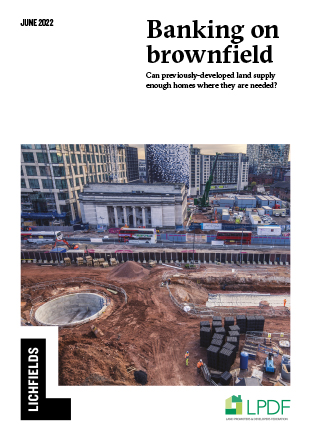Insights
Banking on brownfield
Can previously-developed land supply enough homes where they are needed?
The Levelling up White Paper, 2021 Conservative Party Conference speeches and the £1.5bn Brownfield housing fund have all suggested brownfield land as the solution to meeting the country’s housing needs.
This report considers whether brownfield land is sufficient in size, in location and in its deliverability, to perform that role. We have analysed all local authority Brownfield Registers. We find that, even if every identified site was built to its full capacity, the capacity of previously-developed land equates to 1,400,000 net dwellings. This equates to just under a third (31%) of the 4.5m homes that are needed over the next fifteen years. Even with significant government support, brownfield land can only be part of the solution to the housing crisis. Further, brownfield land is not evenly distributed, and not well aligned to current demand for new homes.
There is less brownfield land available in the places with the highest demand for new homes. The three regions where brownfield land is most relatively prevalent (North West, Yorkshire and the Humber and North East), are those where the price of homes is more closely aligned to average incomes.
Even in these regions, the capacity on registers is less than the current level of housing need. If ‘levelling up’ achieves economic re-balancing and drives higher levels of housing need, the gap between capacity of previously-developed land and homes needed will grow. Further, the type of homes that might be built on brownfield sites do not always match local housing needs and aspirations.
The capacity of land on the Brownfield Register is expected to deliver many sites at high densities, leaving little space for new family homes with gardens. 48% of the homes on proposed sites on the register are likely to be apartments (sites of over 100dpa) whereas just 17% of households across the country are likely to live in apartments. This means there is a ratio of one new brownfield home to every six households likely to live in apartments but one to 27 for houses. This mismatch can be even more striking at the local level.
The competition for urban land is ever present, markedly between economic and residential uses. Our research finds the opportunity cost of prioritising brownfield land for housing rather than employment is significant in pricing out industrial and office development to potentially sub-optimal locations. Redevelopment for many employment uses requires less remediation work than for residential land. Additionally, the greater the premium for residential over industrial land, the more significant the challenges are to effectively sustain both jobs growth and housing growth. There is proportionately more brownfield land in markets that have greater viability risks but this is affected by geography. Three quarters of the residential capacity of the register in the North East are in local authorities most at risk of viability issues, whereas none in the South East or South West is. This can also lead to a trade-off between delivering homes on brownfield land and providing subsidised and affordable housing; the additional cost and risk of developing brownfield land makes delivering affordable housing more challenging on those sites.
Our research also finds brownfield land data to be lacking in the comprehensiveness, accuracy and detail required to make effective policy decisions. The data in the Brownfield Registers is often out of date and suffers from the apparent inclusion of a large number of duplicates and/or overlapping entries. Throughout our study we refer to the figures on the Brownfield Registers that have been ‘cleaned’ of duplicates, our method is described in section 2. For all stakeholders, better information is required to improve decision making and ensure that plan-makers base their strategies on accurate information.
Sectors

Download the report
Read the full report in PDF format.



